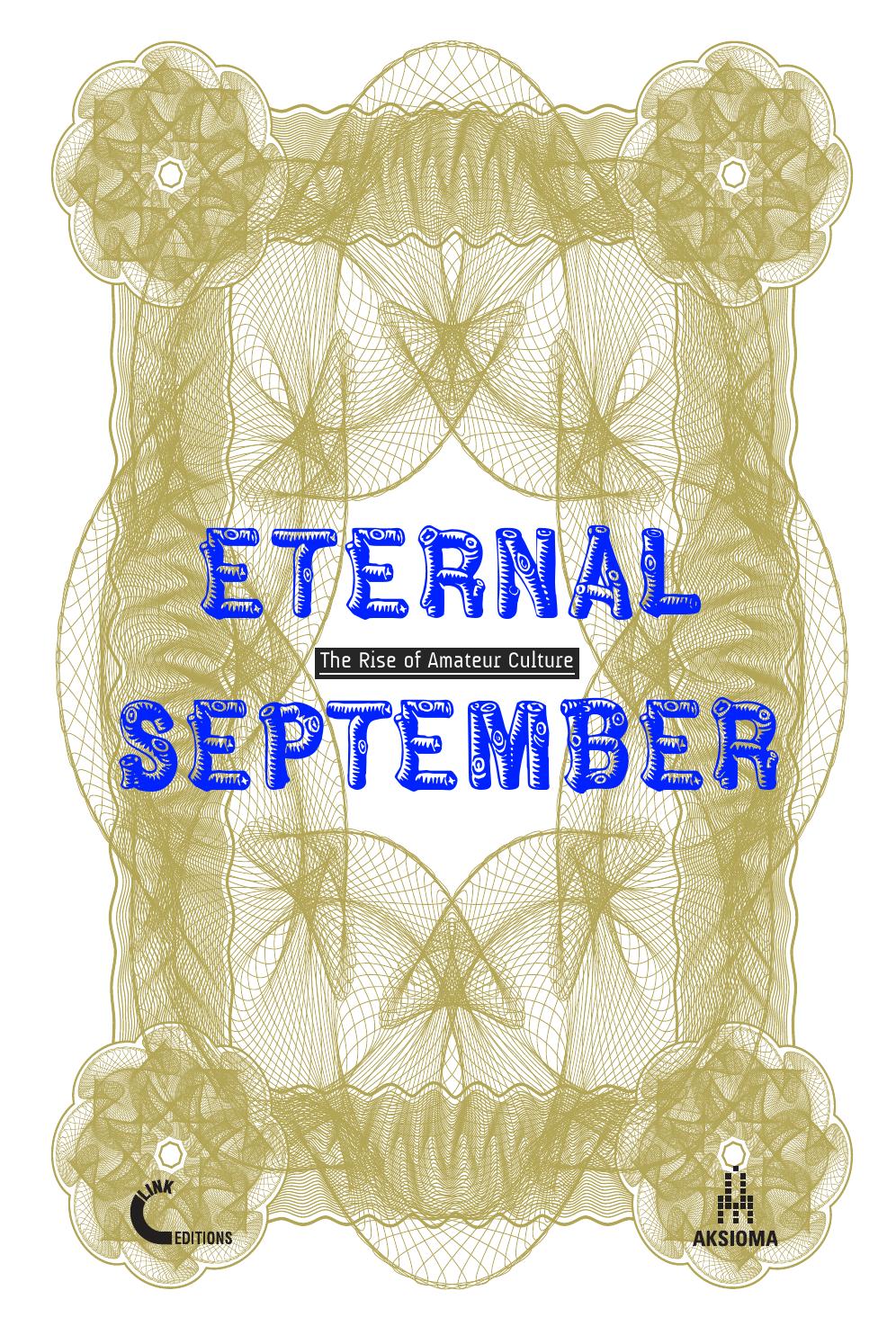Eternal September. The Rise of Amateur Culture (2014)
Filed under catalogue | Tags: · amateur culture, art, copyright, memes, online video, visual culture, web

Curated by Valentina Tanni, Eternal September. The Rise of Amateur Culture is a group exhibition that explores the relationship between professional art making and the amateur cultural movements through the web.
This catalogue features a curatorial text by Valentina Tanni, together with an interview with artist Matthias Fritsch, the man beyond the Teknoviking meme, an essay by artist group Smetnjak on practicing critical theory in the form of internet memes, visual documentation of Tanni’s ongoing curatorial project The Great Wall of Memes, and a section dedicated to the works of 15 exhibited authors.
Publisher Link Editions, Brescia, with Aksioma, Ljubljana, September 2014
Creative Commons BY-NC-SA 4.0 International License
ISBN 9781291980608
82 pages
Metahaven: Can Jokes Bring Down Governments? Memes, Design and Politics (2013)
Filed under pamphlet | Tags: · activism, design, fun, memes, politics, power

“These are serious times, or so our governments keep telling us. Strangling economies with their austerity policies, they assure us that they have no choice. In a world where “there is no alternative”, how do you dissent? Once upon a time, graphic designers would have made political posters and typeset manifestos. Today, protest has new strategies. Enter the internet meme. With its Darwinian survival skills and its viral potential, the meme is a way of scaling up protest. Hackers and activists have learned to unleash the destructive force of a Rick Astley video. They have let slip the Lolcats of war. Pranks have become a resistance strategy. As the rise of Beppe Grillo in Italy testifies, this may be the hour to fight nonsense with nonsense. Jokes are an open-source weapon of politics, and it is time to tap their power.”
Publisher Strelka Press, 2013
ISBN 9785906264077
Review (Shumi Bose, Blueprint)
Publisher
Authors (in an interview with Aaron Peters)
Tony D. Sampson: Virality: Contagion Theory in the Age of Networks (2012)
Filed under book | Tags: · affect, assemblage, biology, biopower, capitalism, contagion, memes, memetics, networks, politics, sociology, theory, unconscious, virality, virus

“In this thought-provoking work, Tony D. Sampson presents a contagion theory fit for the age of networks. Unlike memes and microbial contagions, Virality does not restrict itself to biological analogies and medical metaphors. It instead points toward a theory of contagious assemblages, events, and affects. For Sampson, contagion is not necessarily a positive or negative force of encounter; it is how society comes together and relates.
Sampson argues that a biological knowledge of contagion has been universally distributed by way of the rhetoric of fear in the antivirus industry and other popular discourses surrounding network culture. This awareness is also detectable in concerns over too much connectivity, such as problems of global financial crisis and terrorism. Sampson’s “virality” is as established as that of the biological meme and microbe but is not understood through representational thinking expressed in metaphors and analogies. Rather, Sampson interprets contagion theory through the social relationalities first established in Gabriel Tarde’s microsociology and subsequently recognized in Gilles Deleuze’s ontological worldview.
According to Sampson, the reliance on representational thinking to explain the social behavior of networking—including that engaged in by nonhumans such as computers—allows language to overcategorize and limit analysis by imposing identities, oppositions, and resemblances on contagious phenomena. It is the power of these categories that impinges on social and cultural domains. Assemblage theory, on the other hand, is all about relationality and encounter, helping us to understand the viral as a positively sociological event, building from the molecular outward, long before it becomes biological.”
Publisher University of Minnesota Press, 2012
ISBN 0816670056, 9780816670055
235 pages
Review: Jussi Parikka (Theory, Culture & Society)
Book video (University of Amsterdam students)
Author’s research blog
Publisher
PDF, PDF (updated on 2017-9-29)
Comments (2)
